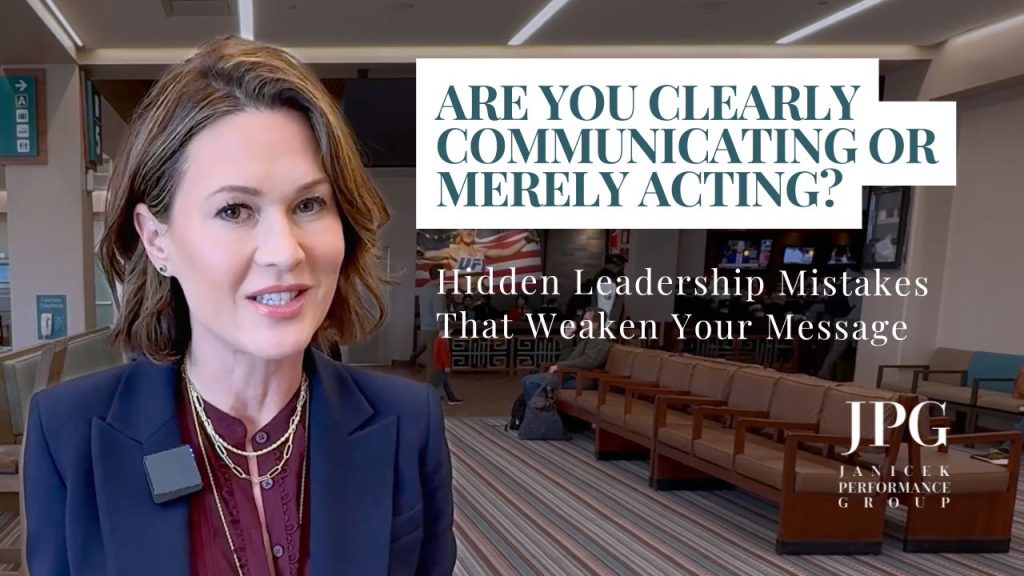Hidden Leadership Mistakes That Weaken Your Message
Leaders are communicators. Whether you’re setting a vision, delivering critical updates, or guiding your team through uncertainty, the way you speak determines how your message is received.
Effective leadership communication isn’t just about what you say—it’s about ensuring that your audience understands and retains your message.
Recently, I was reminded of this on a flight.
The pilot had important information to share:
- Upcoming turbulence
- Landing times
- Other key flight details
But no one heard him.
The Problem: Performance Over Clarity
Instead of delivering the message in a clear, direct way, the pilot decided to entertain. He played with his inflection, switched up his voice, and even channeled his inner DJ. What could have been a straightforward announcement turned into a performance.
The result? A plane full of passengers who had no idea what he was saying. This is the same mistake many executives and leaders make in high-stakes communication moments. Whether it’s a company-wide address, a board meeting, or a media interview, true executive presence isn’t about theatrics—it’s about commanding attention, building trust, and ensuring your message lands with impact. Through executive presence coaching, professionals learn how to refine their delivery, project confidence, and communicate with clarity—so their message resonates, rather than gets lost in the noise.
What Executive Leaders Can Learn from This
We see this happen all the time in leadership. A leader delivers an important message, but the way they present it dilutes the meaning.
Common mistakes leaders make:
- Being overly casual when seriousness is required
- Trying too hard to be humorous
- Burying the key message under unnecessary theatrics
When that happens, clarity is lost. Confusion takes over. And the impact of the message? Gone.
In business communication, executive presence matters. Your words should establish authority, build trust, and inspire action. If people don’t understand or remember your message, it’s as if you never delivered it in the first place.
How to Communicate With Impact
If your message is important, make sure it is:
- Simple – Get to the point quickly so there’s no room for misinterpretation.
- Concise – Avoid unnecessary fluff and distractions.
- Understandable – Use direct language that resonates with your audience.
- Structured – Organize your message in a logical way that makes retention easy.
- Relevant – Tailor your communication to your audience’s needs and expectations.
Whether you’re an executive speaking to stakeholders, a doctor explaining treatment options to a patient, or a CEO delivering a media statement, the way you present your message will determine its effectiveness.
The Role of Emotional Intelligence in Leadership Communication
A key aspect of strong leadership communication is emotional intelligence. Great leaders understand when to be engaging and when to be serious. Emotional intelligence helps leaders read their audience, gauge reactions, and adjust their delivery accordingly. Great leaders are also authentic, which helps build trust.
If the pilot had been more self-aware, he might have realized that his passengers weren’t engaging with his announcement—they were confused. Similarly, leaders must pay attention to body language, tone, and audience feedback to ensure their message is landing as intended.
Through executive presence coaching, leaders refine these skills—learning how to control tone, read body language, and command attention with authenticity, so their message lands with clarity and confidence.
Common Public Speaking Pitfalls Leaders Should Avoid
Even experienced professionals can make communication mistakes
Here are some common pitfalls and how to avoid them:
- Overcomplicating the Message: Using jargon or long-winded explanations can make your audience disengage. Instead, simplify complex ideas into digestible, actionable takeaways.
- Failing to Engage the Audience: While being overly entertaining can be a distraction, failing to engage at all can be just as damaging. Find a balance between clarity and connection.
- Neglecting Nonverbal Communication: Your body language, eye contact, and tone of voice contribute as much to your message as the words themselves. Make sure your nonverbal signals align with your intent.
- Talking Too Much Without Listening: Great communicators know when to pause and invite input. Give your audience a chance to process and respond.
Leadership Isn’t About Putting on a Show
There’s a time for humor. There’s a time to entertain. But when the stakes are high, when clarity is key, your responsibility as a leader is to make sure people hear and understand what truly matters.
Your words can inspire, guide, and lead. But only if your audience actually hears them.
At Janicek Performance Group, we specialize in helping executive leaders refine their communication skills so their message cuts through the noise. If you’re ready to elevate the way you communicate, let’s talk.





